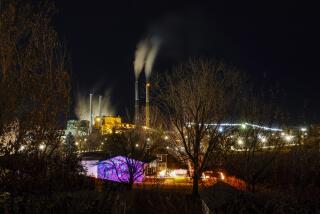Uranium Mills Close as Boom Turns Into Bust
- Share via
BLANDING, Utah — The 130 workers at the White Mesa Uranium Mill here in Southeastern Utah near Four Corners know they will lose their jobs next May.
“We’re the lucky ones. We’re still working,” said Dan Hunt, 40. He wears a respirator as he weighs uranium oxide concentrate, commonly called “yellowcake,” the mill’s final product.
Hunt has been working in uranium mines and mills since he was 18. Like all who work at White Mesa, he doesn’t consider this a life-threatening or dangerous occupation.
“You respect the risks involved working with radioactive material but don’t worry about it as long as proper safety precautions are taken at all times,” he insisted.
Hunt and his fellow employees are happy to be working because the uranium industry is in a terrible slump.
During the uranium boom of the late 1970s, more than 22,000 Americans were employed in the exploration, mining and milling of uranium. Today, the industry has jobs for fewer than 1,000.
In the industry’s peak years, U.S. uranium production reached 44 million pounds. By 1985, it skidded to 11 million pounds, with total world production at 90 million pounds.
At the uranium boom’s height, 25 mills operated in the United States. White Mesa this year will mill more than 5 million pounds of uranium, or about half the nation’s domestic output. It is one of only three such mills now in full operation. Two others run at limited capacity.
“This plant was built at a cost of $40 million. It went into operation in May, 1980, and shut down two years later because of the depressed market,” explained plant superintendent Don Sparling, 56.
“White Mesa fired up again in October, 1985. The reason we are running again is because we have a source of high grade ore not too far away and a lot of automation in the plant, enabling us to make a profit.”
When the White Mesa mill went back on line it was supplied with enough Arizona uranium ore--175,000 tons--to keep operating for at least 18 months. But when that stockpile runs out next May, the plant again will be shuttered until the raw material supply is built up again to enable it to restart.
“The Arizona mines ship the high-grade ore to White Mesa, but milling is much faster than mine production,” explained Sparling.
He tersely told the uranium industry’s recent tale of woes: “Large increases in electrical consumption were predicted. Nuclear power was a rising star in the energy field” in the late 1960s and early 1970s, Sparling recalled. “Utilities planned and constructed more and more nuclear power plants, creating an impetus for heavy domestic production of uranium.”
By the late 1970s, 100 uranium mines were in production in several Western states. Twenty-five mills were erected. And the price of uranium shot up as high as $40 a pound.
Then, beginning in 1981, came the fall, said Sparling. “The increased financial burden of building the plants surfaced. Cancellations of nuclear plant (construction) started after the Three Mile Island incident. Problems were occurring in other plants. Stringent regulations were adopted.”
He added, “The demand for electrical consumption did not meet projections. Coal became a major energy source. The industry took a nose dive.”
By last fall, the price of uranium--today at $17.25 a pound--had plummeted to $14.25. And, Sparling said: “Other mining economics went into play. Canadians found richer grade uranium deposits while U.S. producers in the main were dealing with low-grade ore production.”
When White Mesa shuts down next May, it will have a jarring effect on Blanding and all of Utah’s San Juan County.
More to Read
Sign up for Essential California
The most important California stories and recommendations in your inbox every morning.
You may occasionally receive promotional content from the Los Angeles Times.










